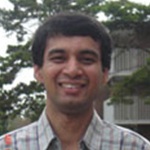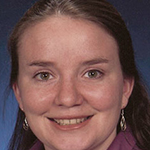*Tech = Technological Institute (2145 Sheridan Road)
**Db = Dearborn Observatory (2131 Tech Drive)
Spring Quarter 2010
| Date/Time | Visitor / Seminar | |
| June 10 Db 23 4:00 pm |
 |
James Guillochon White dwarfs, the end point of stellar evolution for stars with masses from about 0.07 to 8 solar masses, are extremely common, with several billion of them residing in the halo of the Milky Way. White dwarfs are frequently observed to be members of binary systems with normal stellar companions, and less frequently, with compact stellar companions. White dwarfs are particularly interesting because they are the densest concentrations of nuclear fuel in the universe. In fact, the accretion-induced collapse of a white dwarf near the Chandrasekhar limit is also the limit for thermonuclear explosions. However, white dwarfs do not need to exceed the Chandrasekhar limit to be capable of exploding. I will describe alternative mechanisms for white dwarf ignition, such as collisions between white dwarfs in dense stellar environments, tidal encounters with massive black holes, or the accretion of dense material from a low-mass white dwarf companion. |
| May 20 Db 23 4:00 pm |
 |
Charles Bailyn I will describe recent observational studies and modelling of stellar-mass black holes in binary star systems. Optical/IR studies with small ground-based telescopes are generating detailed constraints on the geometry of these systems, and providing new insight into the dynamics of accretion flows and jets. When combined with observations in other wavelength regimes, strong-field relativistic effects can in principle be identified and studied. |
| May 13 Db 23 4:00 pm |
 |
Panayiotis Tzanavaris Nearby ( less than 100 Mpc) compact groups of galaxies represent a special high-density environment, which, thanks to their relative proximity, can be studied in detail. The similarity of compact groups to dense environments at high redshift makes them an ideal laboratory for gaining insight on galaxy evolution and transformation in the distant Universe, where merging and interactions are prevalent. I will present an introduction to Hickson Compact Groups (HCGs) and our multi-wavelength sample of 12 HCGs. This talk will focus on the combination of Swift/UVOT 3-color UV data and Spitzer/24-micron data for estimating specific star-formation rates for our sample. These results show some intriguing trends, and I will discuss the possible implications for galaxy evolution in the special HCG environment. |
| May 6 Db 23 4:00 pm |
 |
Marta Volonteri We can trace the presence of massive black holes, weighing millions to billions of solar masses, all the way to early cosmic times, as the engines powering luminous quasars. Dynamical evidence also indicates that massive black holes ordinarily dwell in the centers of most nearby galaxies, and that black hole masses scale with the properties of their host (velocity dispersion, mass). In this talk I will address some questions that relate massive black holes to their hosts. Do all galaxies host a massive black hole? How can we test how massive black holes formed in the first galaxies? What is the interplay between massive black hole dynamics and accretion in galaxy mergers? |
| April 14 Db 23 4:30 pm |
Lingzhen Zeng I will first give a brief introduction to cosmology and the B mode polarization. Then I will introduce the CLASS project which aims the to detect the CMB B mode polarization. Finally, I will focus on the smooth-walled feedhorn design for CLASS. |
Winter Quarter 2010
| Date/Time | Visitor / Seminar | |
| March 1 Db 23 4:00 pm |
 |
Ravi Kopparapu The population of Double white dwarf (DWD) and neutron star-white dwarf (NSWD) binaries in our Galaxy are considered to be some of the most promising gravitational-wave (GW) sources for LISA. Electromagnetic observations have already discovered several of these white-dwarf binary systems in various phases of their evolution in LISA's band of detection. Here I will illustrate how one can draw similarities between the familiar color-magnitude diagram (CMD) of stars in astronomy, to a population boundary diagram for white-dwarf binary systems emitting GWs in LISA band. Depending upon the precision with which LISA can measure the frequency evolution ($\dot f$) of a white-dwarf binary system I will show that it may be possible to distinguish between a DWD and a NSWD system, and possibly the composition of the donor white dwarf. I will discuss the limits and applicability of these boundaries with respect to observations and find that a measurement of $\dot f$ by LISA at high frequencies ($log [f ] \ge 2$) would likely distinguish between DWD/NSWD binary. For low-frequency sources, GW observations alone would unlikely tell us about the binary components, without the help of electromagnetic observations. |
| Feb. 24 Db 23 11:00 am |
Sambaran Banerjee We study the dynamics of stellar-mass Black Holes (BH) in star clusters with particular attention to the dynamical formation of BH-BH binaries, which are particularly interesting as sources of gravitational waves (GW). We examine the dynamical properties of these BH-BH binaries through direct N-body simulations of Plummer clusters of N = 10^5 low mass stars with an initial population of stellar mass BHs, using the N-body integration code NBODY6. We find that the stellar mass BHs segregate rapidly into the cluster core and form a dense sub-cluster of BHs in which BH-BH binaries form through 3-body encounters. While most BH binaries are ejected from the cluster by recoils due to super-elastic encounters with the single BHs, we fi nd that for clusters with N<=5x10^4, typically a few of them harden suffciently so that they can merge via GW emission within the cluster. Also for each of such clusters, there are several escaping BH binaries that merge within a Hubble time, most of the merger occurring within a few Gyr. These results imply that the intermediate-age massive clusters constitute the most important class of star cluster candidates that can produce dynamical BH-BH mergers at the present epoch. Old globular clusters cannot contribute substantially to the present-day BH-BH merger rate since most of the mergers from them would have happened much earlier. On the other hand, young massive clusters with ages less that 50 Myr are too young to produce significant number of BH-BH mergers. The BH-BH merger rates obtained from our computations imply a significant detection rate (~30 per year) for the proposed "Advanced LIGO" GW detector. We discuss possible further improvements over the present work. |
|
| Feb. 2 Db 23 4:00 pm |
 |
Bulent Kiziltan It's been more than 40 years since the discovery of the first pulsar. Since then, these objects have been used as unique cosmic yardsticks by which we continue to test a variety of exotic physics and astronomical phenomena. While we have reached a remarkable precision in pulsar observations, many aspects of our theoretical understanding regarding these objects are still in their infancy. In this talk, I will describe alternative multidisciplinary approaches which we can use to get new insights into a wide range of neutron star properties including details of their evolution, ages, magnetic fields, initial spin periods and masses. I will then discuss how we can use these new constraints to get a variety of interesting science from millisecond pulsars on a broader scale. |
| Jan. 19 Db 23 4:00 pm |
 |
Enrico Ramierz-Ruiz There is now a consensus that gamma-ray bursts involve extraordinary power outputs, and highly relativistic dynamics. The trigger is probably a binary merger or collapse involving compact objects. The various modes of energy extraction from such systems are discussed. Some key theoretical issues are highlighted, along with the types of observation that would discriminate among the various models. |
| Jan. 13 Db 23 11:00 am |
 |
Peter Anders I will present how evolutionary synthesis models (i.e. models which predict the integrated spectra, magnitudes and chemical properties of stellar populations, like star clusters and galaxies) work in general, and what makes our GALEV models special among them. In the second part of the talk I will focus on a particular set of models, where I combine results from N-body simulations (regarding the evolution of the stellar mass function within a star cluster due to interaction with the galactic tidal field) with our GALEV models. I show that the star cluster evolution in a tidal field alters the integrated cluster properties (like masses and colours) significantly, leading to potential misinterpretations of star cluster observations and derived conclusions about galaxy evolution. |
| Jan. 11 Db 23 3:30 pm |
 |
Aaron Geller The old (7 Gyr) open cluster NGC 188 is quickly becoming a benchmark for study of the dynamical impact of a cluster environment on an evolved stellar population. Observations have shown that NGC 188 is home to a rich binary population and a wide variety of intriguing stars, including blue stragglers, sub-subgiants and X-ray sources. Indeed, this abundance of anomalous stars is likely a direct result of the dynamical evolution of the single- and binary-star systems as they have interacted over the lifetime of the cluster. I will discuss the results of our decade-long WOCS survey of NGC 188, focusing on the binaries and blue stragglers, and talk about our landmark N-body simulation of the cluster. The observed characteristics of the NGC 188 blue stragglers are some of the most distinguishing properties of an open cluster blue straggler population found to date, and the ability to match these characteristics within a realistic open cluster simulation may finally pull back the veil over the origins of the NGC 188 blue stragglers. |
Fall Quarter 2009
| Date/Time | Visitor / Seminar | |
| Nov. 11 Db 23 12:00 pm |
 |
Ann Hornschemeier The International X-ray Observatory (IXO), a joint ESA-JAXA-NASA effort, will address fundamental and timely questions in astrophysics: What happens close to a black hole? How did supermassive black holes grow? How does large scale structure form? What is the connection between these processes? To address these questions IXO will trace orbits close to the event horizon of black holes, measure black hole spin for several hundred active galactic nuclei (AGN), use spectroscopy to characterize outflows and the environment of AGN during their peak activity, search for super-massive black holes out to redshift z = 10, map bulk motions and turbulence in galaxy clusters, find the missing baryons in the cosmic web using background quasars, and observe the process of cosmic feedback where black holes inject energy on galactic and intergalactic scales. IXO will employ optics with 3 sq m collecting area and 5 arc sec angular resolution - 20 times more collecting area at 1 keV than any previous X-ray observatory. Focal plane instruments will deliver a 100-fold increase in effective area for high-resolution spectroscopy, deep spectral imaging over a wide field of view, deep polarimetric sensitivity, microsecond spectroscopic timing, and high count rate capability. The mission is being planned for launch in 2021 to an L2 orbit, with a five-year lifetime and consumables for 10 years. This talk will give a basic overview of the science case for the mission as well as the mission's design. |
| Oct. 9 Db 23 12:00 pm |
 |
Tim Linden There is currently a significant effort to indirectly detect dark matter through the observation of stable products of dark matter annihilation. Cutting edge observations have allowed us to inspect the expected dark matter signal from both massive particles and photon energies spanning 16 orders of magnitude. However, the current results have been inconclusive, and sometimes contradictory. One interesting result was an unexpected synchrotron haze (the øWMAP hazeø), with a similar intensity and morphology to those predicted by theoretically motivated dark matter models. We evaluate a wide variety of well motivated dark matter particle physics setups as well as cosmic ray propagation models, and compare the simulated dark matter driven synchrotron signal against the observed WMAP haze. Further analyzing several reasonable dark matter fits to the WMAP haze, we determine the expected inverse-Compton scattering and positron/electron signals which should be detectable by cutting-edge Fermi and Pamela observations. Finally, we will investigate the role that astrophysical uncertainties play in our attempts to detect a resilient dark matter signal. |
| Sept. 24 Db 23 3:00 pm |
 |
Smadar Naoz The formation of the first generation of galaxies in the Universe has been studied for many years. We studied this epoch taking into account important physical ingredients. We show that these ingredients play a major role in the evolution of over-densities both in the linear and non-linear regime and on the formation and properties of the first luminous objects in the Universe. We give a detailed set of predictions for these objects, and in particular show that the first observable star was most likely to form only 30 million years after the big bang (at redshift 65), with the first Gamma ray burst exploding only a few million years later. Observations of the 21cm radiation from these epochs will help unfold the cosmic evolution of the first generation of galaxies. These observations are strongly affected by the UV radiation from stars at this era which couples the properties of the 21cm signal and the distribution of the first galaxies. Using an accurate analysis of this coupling process, including the ionized gas bubble around each galaxy, we predict a clear signature of this process. We show that such observable signatures can be used to detect and study the population of galaxies that formed as early as 200 Myr after the big bang. |
Past CIERA Special Seminars